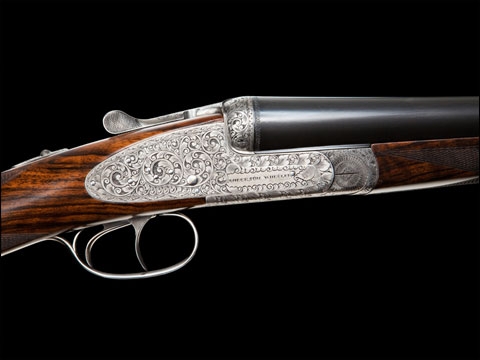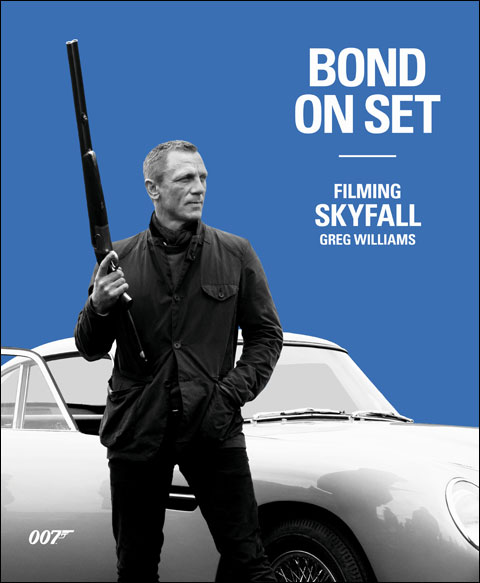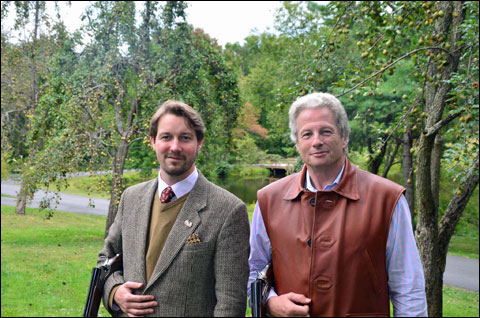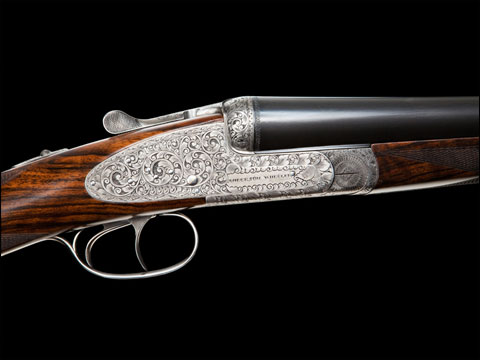Is That an Anderson Wheeler You’re Shooting, Mr. Bond?

In the James Bond movie “Skyfall,” Agent 007 (Daniel Craig) uses a .500 Nitro Express Double Rifle to kill dangerous game of the two-legged variety from the little-known London gunmaker, Anderson Wheeler.
Managing Director, Stuart Anderson Wheeler, is a professional hunter who leads expeditions to East and Central Africa pursing four-legged dangerous game. He’s a late thirty-something, soft-spoken Englishman with a trim beard and sporting an ascot.
 Daniel Craig as Agent 007 wielding an Anderson Wheeler .500 Nitro Express Double Rifle in “Skyfall.”
Daniel Craig as Agent 007 wielding an Anderson Wheeler .500 Nitro Express Double Rifle in “Skyfall.”At a North Carolina strip-mall steak house his tale of hunting buffalo in Tanzania trickled through the conversational din from several seats away giving him that Bondish air of mystery and intrigue.
Self-assured yet modest, Mr. Anderson Wheeler’s British discretion draws you in by virtue of particulars over volume. His understated, aristocratic demeanour is also fully articulated in the Anderson Wheeler catalogue of fine shotguns currently imported exclusively into the U.S. by the venerable retailer of fine sporting firearms, Griffin & Howe.
 Stuart Anderson Wheeler (left) with Guy Bignell.
Stuart Anderson Wheeler (left) with Guy Bignell.“Griffin & Howe is staying on the cutting edge of the industry looking for the best of the best at a price point,” said Guy Bignell, the company’s CEO. “Stuart Anderson Wheeler is a conscientious young man, a professional in the gun business from the get-go. And now after more than three years, our collaboration is producing a collection of the very best London shotguns currently available at an affordable price point.”
Why the “Skyfall” armourer selected Anderson Wheeler is a question that, as shotgun enthusiasts, causes us to reconsider our own roster of usual suspects in the premium London gun trade.
At first blush, the Anderson Wheeler exquisite sidelock side by side and sideplate boxlock over/unders possess the ability to magnetize you from afar and charm you towards them. Ultimately it’s the surprisingly affordable $18,000 price that completes the seduction.
 Stuart Anderson Wheeler on safari.
Stuart Anderson Wheeler on safari.Every shotgun takes approximately 12 months to custom build. The Anderson Wheelers are London proofed. The shotguns incorporate exhibition-grade Turkish walnut and striking London hand engraving to create a distinctive but classic elegance.
Still, as a third-generation big-game hunter, Mr. Anderson Wheeler appreciates full well the value of firearms dependability. That’s why, although the receiver and barrels are commissioned, the triggers on the shotguns are manufactured in-house on state-of-the-art CNC machines.
The aesthetics, meanwhile, emerge from the Anderson Wheeler craftsmen who soften the bottom edges of the receiver and, in the finest London gunmaking tradition, assemble the components with the attention to fit and finish you’d expect from a premium shotgun. Once delivered, the striking shotguns belie their $18,000 price tag.
 The Anderson Wheeler store in London’s historic Shepherds Market.
The Anderson Wheeler store in London’s historic Shepherds Market.In business since 2006, Anderson Wheeler is still regarded as a relatively new London gunmaker and luxury goods firm. The company’s compact premises in Shepherds Market not only house their guns, but lovely up-market fly fishing gear, clothing, accessories and luxury travel. It’s not surprising to see Mr. Anderson Wheeler walk through the front door after leading a big-game hunt in the Congo Basin. Consequently, Anderson Wheeler shotguns are derived from the standpoint of a professional hunter.
 The Anderson Wheeler side by side.
The Anderson Wheeler side by side.The Anderson Wheeler side by side is a seven-pin sidelock ejector. The sidelocks are hand-polished internally. The shotguns employ intercepting sears and feature cocking indicators. The approximate weight of a 20-bore with 29-inch barrels is 6 pounds, 5 ounces.
The action is drop-forged steel for maximum strength. Think of drop forging as modern-day blacksmithing, where a machine die that contains the shape of the finished products is power-hammered onto the raw material.
The side by sides can be ordered in .410 or 28, 20, 16 and 12 bore. Chopper-lump barrels can be proof tested for steel shot. Available lengths range from 26 to 30 inches with fixed chokes as per the client’s specifications.
 Anderson Wheeler’s over/under shotgun.
Anderson Wheeler’s over/under shotgun.Anderson Wheeler’s over/under ejector shotgun can be fitted with a selective single-trigger and barrel selector/safety or double triggers. A 20 bore, for example, weighs 6 pounds, 11 ounces while the 12 bore is 7 pounds, 13 ounces.
The reinforced action is hand-engraved with the company’s trademark bold foliate scroll on either a coin or case-colored finish. A custom engraving option is available, and can be designed with the assistance of the Anderson Wheeler in-house artist.
The chopper-lump barrels, steel-proofed and available in lengths from 28 to 30 inches, can be specified with fixed or screw-in chokes. The over/under is offered in the same gauges as the Anderson Wheeler side by side.
Stock configurations for the over/under include pistol and straight English grip. Hand-rubbed, oil-finished stocks and forends are hewn from exhibition grade Turkish walnut.
“The grade of wood, the hand engraving, is without equal at that price point, and as you would expect to find on a $100,000 gun,” noted Mr. Bignell.
So how do the individual components add up in the field when shooting an Anderson Wheeler?
In person, the Anderson Wheelers radiate exclusivity. The engraving is clearly associated with a premium, traditional shotgun rendered with a contemporary flair. The wonderfully figured wood bears that London gun-room disposition. Snug wood-to-metal seams whisper of hand fitting.
We had the opportunity to shoot 5-stand with the 12 and 20 bore over/unders to form a few quick impressions.
Handling the Anderson Wheelers communicates first-class comfort. Best quality British over/unders convey a sense of high performance through nimble handling and refined grace. We wouldn’t go quite so far as to compare the Anderson Wheeler’s shooting characteristics with a Holland & Holland Royal Deluxe over/under; the difference between the guns can be described as “maturity.” Of course the Holland & Holland will cost you about $157,000 and presents itself in pure magnificence. But the Anderson Wheeler possessed a younger soul that was more vigorous and impetuous than London’s pedigree yet still quite British with a mannerism of entitlement, competence and poise.
Starting with the 20 bore, we found the Anderson Wheeler sprightly and appealing. The trigger felt communicative and smooth — just the qualities you’d appreciate for a flushing covey. Shooting low gun, the mount to shoulder and face was measured and would probably be a welcome relief to shooters accustomed to twitchy sub-gauge shotguns eager to overshoot swift quarry. Trigger draw proved effortless and efficient. The fixed chokes were modified and modified-plus. Barrel regulation seemed excellent, delivering authoritative breaks.
Some trial and error was involved in determining the point of impact, which revealed itself as near-flat — practically eliminating vertical target float for the stock at hand. In terms of ordering a bespoke Anderson Wheeler, the stock fitter will measure your dimensions.
Moving to the 12-bore over/under, the receiver’s curved bottom edges reduce that bulky heft of a large-bore boxlock. Certainly the 12 bore is heavier, although the contour of the receiver mitigates the conspicuous change-up from a 20 bore.
The 5-stand wobble threw the occasional low zinger. Anderson Wheeler’s 12 bore over/under addressed them with a judicious steadfastness that neutralized the impulsive rush to action those targets can conjure. Smooth, balanced swings were inspired by a beautifully contoured Schnabel forend. The 12 bore’s outstanding sight pictures were appreciated for the full array of target presentations as singles, report pairs and true pairs. In addition, the zero-creep trigger, at approximately 4 pounds, initiated quick clays hits from the ready position.
Overall, Anderson Wheeler asserts a compelling proposition for the boutique London shotgun at $18,000.
Irwin Greenstein is the publisher of Shotgun Life. You can reach him at contact@shotgunlife.com.
Useful resources:
The Anderson Wheeler web site
The Griffin & Howe web site

Irwin Greenstein is Publisher of Shotgun Life. Please send your comments to letters@shotgunlife.com.


Comments